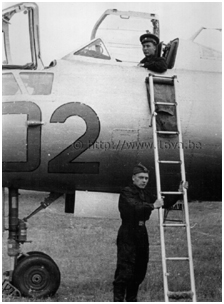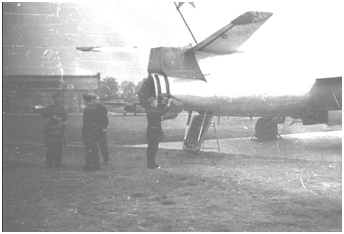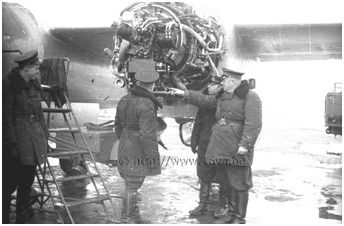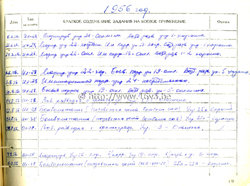
 1955 begins with a test flight with an Il-28 on January 15. On the 21st, two training flights are flown (interaction with the AAA) in a Po-2.
On the same day, two Il-28 flights are also carried out to Altengrabow, thus an outbound and a return flight. January ends with a target-towing flight (AAA interaction).
Nine target-towing missions (AAA interactions) in Il-28s are flown in February. No less than four exercise flights related to airfield approach systems (non-directional approach beacons)
are conducted in Il-28s on the 7th. Unexpectedly, a radio training flight takes place aboard an Li-2 on the 19th. Two Li-2s were observed in June at Altes Lager
and two more were observed at Zerbst when the unit was based there.
March is quieter with only three flights in Il-28s: two target-towing (AAA interaction) and one navigation flights.
Nothing in April/May and just two flights in June. A target-towing (AAA interaction) mission is described as special. The second flight is a night navigation sortie at 800 meters altitude.
Eight collaboration flights with the AAA, one of which at night are carried out in July. They are all described as "special," but this will still be the case in the following pages of the flight log.
This does not necessarily mean that these were specific missions.
Four more missions to interact with the AAA, of which only two are qualified as specials in August. Six target-towing flights are also qualified as special. A target-towing flight with searchlight pursuit
is also carried out at night. In addition, four local flights are carried out. Finally, a return flight to Zerbst is flown with a Po-2.
September begins with a "special" towing flight. Another special towing mission takes place at night in collaboration with searchlights. Eleven special cooperation flights with the AAA are carried out
during the month, as well as a return flight to Zerbst, still with Il-28s.
September is also the last flying month of the year for Berezin.
1955 begins with a test flight with an Il-28 on January 15. On the 21st, two training flights are flown (interaction with the AAA) in a Po-2.
On the same day, two Il-28 flights are also carried out to Altengrabow, thus an outbound and a return flight. January ends with a target-towing flight (AAA interaction).
Nine target-towing missions (AAA interactions) in Il-28s are flown in February. No less than four exercise flights related to airfield approach systems (non-directional approach beacons)
are conducted in Il-28s on the 7th. Unexpectedly, a radio training flight takes place aboard an Li-2 on the 19th. Two Li-2s were observed in June at Altes Lager
and two more were observed at Zerbst when the unit was based there.
March is quieter with only three flights in Il-28s: two target-towing (AAA interaction) and one navigation flights.
Nothing in April/May and just two flights in June. A target-towing (AAA interaction) mission is described as special. The second flight is a night navigation sortie at 800 meters altitude.
Eight collaboration flights with the AAA, one of which at night are carried out in July. They are all described as "special," but this will still be the case in the following pages of the flight log.
This does not necessarily mean that these were specific missions.
Four more missions to interact with the AAA, of which only two are qualified as specials in August. Six target-towing flights are also qualified as special. A target-towing flight with searchlight pursuit
is also carried out at night. In addition, four local flights are carried out. Finally, a return flight to Zerbst is flown with a Po-2.
September begins with a "special" towing flight. Another special towing mission takes place at night in collaboration with searchlights. Eleven special cooperation flights with the AAA are carried out
during the month, as well as a return flight to Zerbst, still with Il-28s.
September is also the last flying month of the year for Berezin.
Sixty-six sorties lasting 82 hours and 57 minutes are logged for 1955, but, in reality, only 65 can be counted in Section III.
Fifty-four day flights (instead of 55) and 4 night flights concern the Il-28, 6 the Po-2 and one flight is made in an Li-2.
At the conclusion of each month in Section III, the seal of FPN 68083 is applied and the document is signed by Colonel Shepelev, Chief of Staff of FPN 68083.

 1956 will be the last active year in the 931.OKRAP for Berezin. It also marks a change in activity for the navigator, or even a reorganization of the unit that then seems to cease
target-towing missions and cooperation with the AAA. Berezin will only fly with Il-28s - probably R versions now - and the first local flights take place in February most probably from Zerbst from now on.
March begins with Navigation Exercise 21. Two other navigation flights also include simulated reconnaissance and spotting (correction) phases. March ends with three local night flights on the 28th.
Only one local flight is completed in April.
Nothing in May and four exercise flights on June 28.
Five exercise flights over two days for July as well as a combat spotting (korr) mission.
August is much more active and starts with two flights of night exercises. A combat spotting flight takes place according to Exercise 19-5 procedures. Another spotting flight was completed without further details.
On the 13th, a flight is made to Brand. The next day, reconnaissance exercises are most certainly taking place from Brand, as on the 17th, the destination is Zerbst.
Two local flights take place on the 21st. On the 22nd and 23rd, three night flights are aimed at conducting targets illumination exercises with SAB bombs. The month concludes on the 29th with four reconnaissance
and spotting exercise flights.
In September, five flights are navigation exercises with photographic reconnaissance and combat spotting. SAB 100-50 illumination bombs are used on two night flights. Five other night flights are
reconnaissance and spotting exercises.
In October, the FKP machine gun is used in two photographic reconnaissance flights (probably the S-13 camera mounted inside the glass nose on the left). During a night exercise, the on-board searchlights are used
(the landing lights on the engine pods?). A spotting simulation exercise flight takes place on the 16th. Finally, three Exercise 64 flights are carried out on the 24th.
Berezin's flight log ends with a single unidentified flight on November 19.
1956 will be the last active year in the 931.OKRAP for Berezin. It also marks a change in activity for the navigator, or even a reorganization of the unit that then seems to cease
target-towing missions and cooperation with the AAA. Berezin will only fly with Il-28s - probably R versions now - and the first local flights take place in February most probably from Zerbst from now on.
March begins with Navigation Exercise 21. Two other navigation flights also include simulated reconnaissance and spotting (correction) phases. March ends with three local night flights on the 28th.
Only one local flight is completed in April.
Nothing in May and four exercise flights on June 28.
Five exercise flights over two days for July as well as a combat spotting (korr) mission.
August is much more active and starts with two flights of night exercises. A combat spotting flight takes place according to Exercise 19-5 procedures. Another spotting flight was completed without further details.
On the 13th, a flight is made to Brand. The next day, reconnaissance exercises are most certainly taking place from Brand, as on the 17th, the destination is Zerbst.
Two local flights take place on the 21st. On the 22nd and 23rd, three night flights are aimed at conducting targets illumination exercises with SAB bombs. The month concludes on the 29th with four reconnaissance
and spotting exercise flights.
In September, five flights are navigation exercises with photographic reconnaissance and combat spotting. SAB 100-50 illumination bombs are used on two night flights. Five other night flights are
reconnaissance and spotting exercises.
In October, the FKP machine gun is used in two photographic reconnaissance flights (probably the S-13 camera mounted inside the glass nose on the left). During a night exercise, the on-board searchlights are used
(the landing lights on the engine pods?). A spotting simulation exercise flight takes place on the 16th. Finally, three Exercise 64 flights are carried out on the 24th.
Berezin's flight log ends with a single unidentified flight on November 19.
The 56 hours and 46 minutes of flight counted for 1956 correspond to 55 flights (yet another erroneous total of 56 flights in Section II) divided into 41 daytime and 14 night sorties.
At the conclusion of each month in Section III, the seal of FPN 82377 is applied this time and the document is again signed by Guards Lieutenant Colonel Reutovich, now Chief of Staff of FPN 82377.
We have screened Section III entirely. Now let's continue briefly with the content of the other sections. Section IV is entitled "Combat Employment" - these are missions carried out in both wartime and in peacetime. The 27 A-20 missions Berezin flew reflect the World War II period. But the subtitle of each page is "Brief Description of the Combat Employment Missions" and the data from the old flight log were lost. In addition, the FPN 82377 is applied on the first page, which indicates a very late entry. Then, some missions are again cited for each month of 1952, that is to say a limited repetition without much interest of Section III content. Curiously, subsequent entries relate directly to the year 1956 and are more detailed. Indeed, the missions now are subject to evaluation. Section V consists of counting the number of day and night flights under VFR and IFR conditions. For each mission, everything is detailed with information such as the number of take-offs and landings, flight hours, use of landing aids, visibility conditions, etc. Section VI counts parachute jumps. There are only two, the first in 1944 and the second in 1948, both from a Po-2 at 800 meters. Section VII has already been discussed. Fortunately, Section VIII called "Flight Accidents" is empty and completes the flight log.
 |
Flight Logs < Part 1 | < Part 2 | < Part 3 | < Part 4 | > Part 6 |
 |
Plan du site - Sitemap |  |
